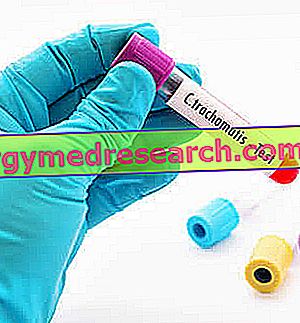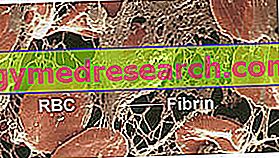Chlamydia is an infectious disease caused by the bacterium Chlamydia trachomatis .

Chlamydia can also be transmitted via the maternal-fetal route.
It is often asymptomatic or slightly perceptible. The first symptoms appear after one or two weeks from the infection.
Usually it is not serious, but in some cases it causes genital lesions of considerable importance (inflammation, progress of infection and ascent; sometimes even permanent sterility).
Together with trichomoniasis and gonorrhea, it is among the most widespread venereal diseases in the world. It affects mainly sexually active subjects who are around 20 years of age.
What to do
- Prevent chlamydial infection (see below under the heading of prevention).
Accusing one or more of the following symptoms it is necessary to go immediately to the doctor.
- Regarding the reproductive system, chlamydia can manifest itself with:
- Abnormal mucous serous or blood loss (even away from the cycle), from the vagina or penis
- Intimate itching
- Pain during urination
- Testicular problems.
- Sometimes small reddish patches appear on the mucous membranes, which can develop into ulcers, lymphogranulomas and fistulation.
- Concerning the anus and the rectum, chlamydia can manifest itself with:
- Anorectal pain.
- Anal spasms.
- Urgent need to defecate.
- Bleeding.
The diagnostic path is not very articulated and is limited to:
- Collection of a cervical, urethral, vaginal or urinary specimen to be analyzed in the laboratory to confirm the identification of the pathogen in question.
What NOT to do
- Dedicate yourself to unprotected sex with occasional partners.
- Have unprotected oral relationships with occasional partners.
- Practice cunnilingus and anilingus (since they cannot be protected) with occasional partners.
- Ignore the symptoms that could signal a chlamydial infection.
- Consume sexual intercourse (cunnilingus and anilingus included) in the presence of symptoms that could characterize chlamydia infection.
- Delay medical supervision.
- Do not carry out a specific investigation with analysis of the buffer; the risk is to confuse the infection with similar ones (gonorrhea, trichomoniasis, etc.).
- Do not follow the drug therapy correctly and do not carry out checks at the end of the course; the risk is that of incomplete healing and relapse.
What to eat
There is no diet that can cure or prevent chlamydia.
On the other hand, certain nutrients are needed to support the immune system; some also exert an antioxidant effect and help prevent free radical stress by improving the general condition.
- Vitamin C or ascorbic acid: it is contained above all in the acidulous fruit and in the raw vegetables. In particular: peppers, lemon, orange, grapefruit, mandarancio, parsley, kiwi, lettuce, apple, chicory, cabbage, broccoli etc.
- Vitamin D or calciferol: it is mainly contained in: fish, fish oil and egg yolk.
- Zinc: it is mainly contained in: liver, meat, milk and derivatives, some bivalve molluscs (especially oysters).
- Selenium: it is mainly contained in: meat, peach products, egg yolk, milk and derivatives, fortified foods (potatoes, etc.).
- Magnesium: it is mainly contained in: oilseeds, cocoa, bran, vegetables and fruits.
- Iron: it is mainly contained in: meat, peach and egg yolk.
- Polyphenolic antioxidants (simple phenols, flavonoids and tannins): they are mainly contained in: fresh fruit and vegetables, but also red wine, seeds, aromatic herbs, tea, roots, cocoa, medicinal herbs, etc.
- Lysine and glycine amino acids: they are mainly contained in: meat, fishery products, cheeses and legumes (especially soya).
- Probiotics: they are mainly found in fermented foods such as yogurt, tofu, tempeh, buttermilk etc.
- Omega 3: are mainly contained in: blue fish, some oily seeds and related oils, algae.
What NOT to Eat
There are no less recommended products than others for the prevention and treatment of chlamydia. However, it is recommended to avoid:
- Monothematic diets.
- Vegan diet.
- Carnivorous diet.
- Diet free of vegetables and vegetables.
- Diet based exclusively on cooked and / or preserved foods.
NB . These recommendations are aimed at ensuring the supply of nutrients useful for maintaining the immune system.
Natural Cures and Remedies
There are no useful natural remedies against chlamydia.
The only safe and effective treatment is the pharmacological one.
However, antibiotics damage the intestinal bacterial flora; in this case, it can be very useful to take specific food supplements to keep it alive and active.
- Probiotic supplements: bifidobacteria, lactobacteria and eubacteria are based. They are used orally on an empty stomach and at least for two weeks.
- Prebiotic supplements: they consist mainly of oligosaccharides, unavailable glucides and fibers. It is necessary that they nourish the intestinal bacterial flora and favor the development of the symbiotic one.
It may be useful to exploit herbal remedies based on immunostimulant plants; the most common forms of intake are extract, decoction and essential oils. Not being responsible for harmful drug interactions, they can also be taken simultaneously with antibiotics:
- Androgafis.
- Astragalus.
- Echinacea.
- Eleutherococcus.
- Mistletoe.
- Uncaria.
- Cordyceps.
- Garlic.
- Aloe gel.
- Turmeric.
Pharmacological care
Antibiotic therapy; your doctor may decide to use one or more of the following drugs:
- Macrolides:
- Azithromycin: eg Azithromycin, Zitrobiotic, Rezan and Azitrocin. A single dose may be sufficient.
- Erythromycin: for example Erythrocin, Erythro L and Lauromycin.
- penicillin:
- Amoxicillin: eg Amoxicillin, Amoxil and Trimox, Zimox and Augmentin.
- Tetracycline:
- Doxycycline: for example Doxicicl, Periostat, Miraclin and Bassado. The treatment lasts at least 7-10 days.
- Tetracycline eg Tetrac C, Pensulvit and Ambramycin.
- Quinolones:
- Ofloxacin for example Exocin and Oflocin.
- Levofloxacin for example Levofloxacin, Tavanic, Aranda and Fovex.
- sulfa drugs:
- Sulfisoxazole.
NB. It is important that the treatment be extended to all sexual partners to avoid the spread of the disorder. For more information, read: Chlamydia drugs
Prevention
- Annual Screeneng, especially for women.
- With new or different sexual partners than occasional ones, dedicate yourself only to relationships protected by a condom.
- With new or non-occasional partners, avoid unprotected oral relationships
- With new or non-occasional partners, always avoid cunnilingus as well as anilingus (as they cannot be protected).
Medical Treatments
Besides the pharmacological ones, there are no other medical treatments for chlamydia.



